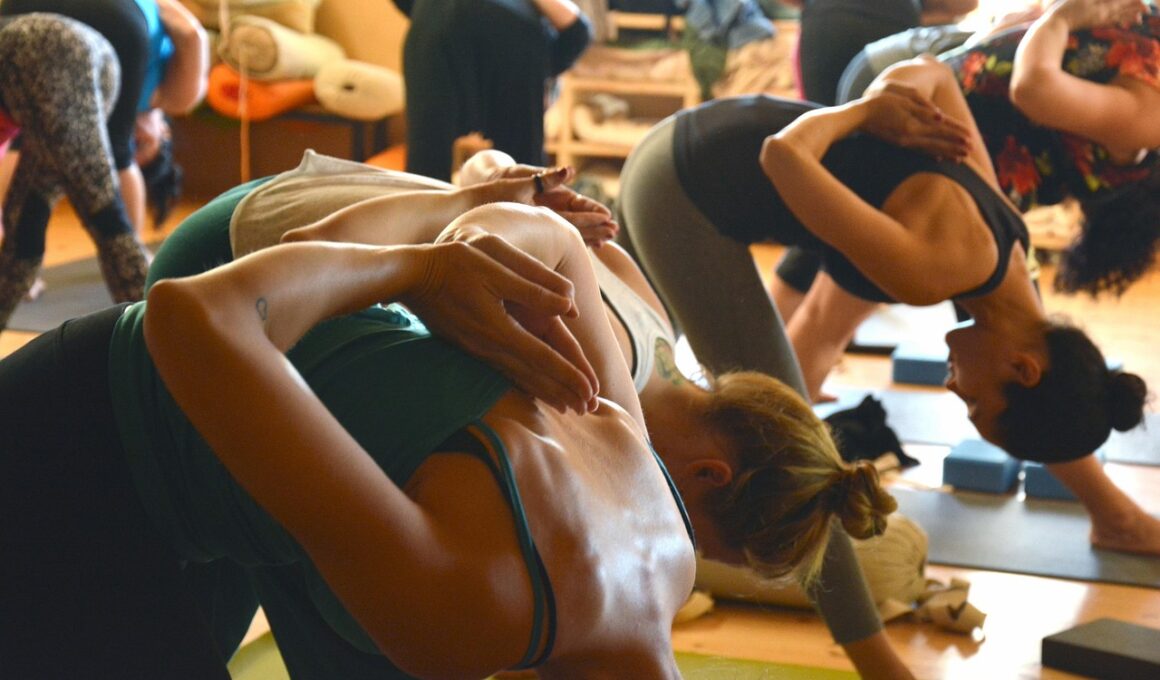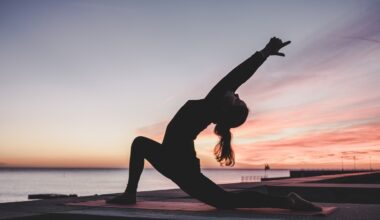Guided Imagery Practices in Group Fitness Settings
Guided imagery is a powerful technique that encourages participants to visualize relaxing scenes and positive outcomes. In group fitness classes, this practice can enhance the overall experience by fostering a sense of community and shared relaxation. Instructors often initiate these sessions with gentle breathwork, helping attendees to settle their thoughts. Following this, specific imagery instructions may guide participants through a serene landscape, such as a beach or peaceful forest. Research has shown that incorporating guided imagery into workouts can significantly reduce stress and anxiety. Additionally, participants tend to report feeling more connected to the group. This shared experience can make exercise feel less daunting and more enjoyable. By practicing visualization techniques, individuals can build mental resilience, which can translate into real-life situations. Some methods include focusing on personal goals and visualizing the journey toward those goals. Practicing guided imagery before engaging in rigorous physical activities appears to enhance outcomes. Participants often find that they feel more energized and in tune with their bodies, which may help them push through challenging workouts while promoting a calmer state of mind throughout their fitness journey.
Integrating guided imagery into group fitness classes offers several benefits. It is not only about physical exertion but also about mental wellness. By incorporating visualization techniques, participants can explore their inner strengths and overcome mental blocks that hinder their performance. Typically, group leaders can help participants use imagery to create personal scenarios, connecting them with their inner motivations. Pre-class discussions can help motivate individuals and build excitement for what lies ahead. During the session, participants might be prompted to visualize themselves successfully completing difficult challenges in a safe and encouraging environment. The power of positive imagery cannot be understated; effectively, it allows individuals to tap into their subconscious, reinforcing their abilities. Over time, this mental training can significantly enhance performance in other physical activities beyond the class itself. Additionally, guided imagery can be especially beneficial for stress relief, allowing participants to unwind. Instructors can facilitate relaxation techniques that include breath awareness and mindfulness alongside guided imagery. As a result, individuals often report lower levels of tension and anxiety, leading to overall improvements in mental health both inside and outside the fitness arena, fostering a harmonious balance in life.
The Role of Instructors
The role of fitness instructors is crucial in effectively implementing guided imagery practices. Instructors need to create a calming environment and establish a sense of trust and safety among participants. Having an inviting atmosphere can significantly impact the effectiveness of the session. Effective communication is key; instructors should clearly articulate guided imagery instructions, ensuring that everyone can easily follow along. Establishing an easy rhythm during the session fosters an inclusive environment for all fitness levels. Additionally, utilizing calming music and ambient sound can enhance the overall experience, providing participants with auditory cues that help to immerse them in their imagery. Some instructors often share personal experiences during imagery sessions, making the practice feel more relatable and less intimidating. Adaptability is essential; instructors should be prepared to adjust their approach based on the group’s feedback and needs. Encouraging participants to personalize their visions can further enhance feelings of ownership and engagement in their wellness journey. Moreover, establishing a post-class discussion can help strengthen community ties and reinforce the positive feelings generated during the exercises. Ultimately, effective facilitation by instructors can maximize the positive effects of guided imagery in the fitness realm.
Incorporating guided imagery exercises into various fitness routines can yield a plethora of benefits for participants. One of the most significant advantages is enhanced relaxation and peace. People enter group fitness classes with numerous stresses and distractions in their lives. Guided imagery provides a mental escape and offers a transitional moment to separate the outside world’s chaos from personal wellness. It seems that many participants feel revitalized and positive after these sessions, recounting profound feelings of connectivity and clarity. This can ultimately lead to more consistent attendance in future classes. Additionally, using imagery can help individuals embrace the present moment, encouraging them to focus on their bodies’ sensations and movements. Learning to control thoughts and cultivate a peaceful mindset is immensely beneficial in managing daily challenges. Moreover, guided imagery can create a sense of camaraderie among class participants, fostering connections that extend outside of fitness sessions. Class members may find that their trust in each other enhances their group progress, ultimately creating a more supportive and encouraging fitness community. Providing a platform for shared experiences can augment motivation levels across various fitness pursuits.
Enhancing Performance Through Visualization
Visualization techniques may significantly affect overall physical performance during group fitness classes. Engaging in weekly guided imagery practices allows participants to set specific intentions for their workouts. By visualizing success and establishing a strong mental image of their fitness goals, individuals can develop greater focus and determination. This enhanced concentration can lead to more productive workout sessions, boosting overall physical performance. Furthermore, maintaining a calm and composed mindset during challenging exercises may result in better execution of techniques and movements. Guided imagery also enhances awareness of proper form and posture. As participants learn to visualize success, they can identify potential areas for improvement, helping to refine their skills. A strong mental image can boost self-confidence, enabling individuals to push through difficult intervals with greater ease and capability. Techniques like mental rehearsal encourage participants to practice movements in their minds before attempting them physically, which can result in a smoother execution when performing the exercises. Additionally, consistently practicing visualization promises to help reinforce positive updates. This ultimately leads to an ongoing sense of empowerment, creating a ripple effect on individuals’ fitness journeys.
When introducing guided imagery techniques to group fitness classes, it’s vital to consider individual differences in response to imagery. Some participants may thrive on visualization, while others might find it challenging. Therefore, fitness instructors should create open dialogues, encouraging individuals to express their feelings regarding these practices. This ongoing communication can help tailor imagery techniques to better suit each participant’s unique preferences. Instructors might provide alternative imagery options or encourage participants to create their scenes, catering to the diverse needs of the group. Furthermore, encouraging journaling after class can help participants articulate their experiences and gain insights into their personal growth. Reflection can also deepen connections to guided imagery practices, promoting retention in their workout routines. However, instructors should remain aware that some individuals might feel skeptical or disconnected from visualization. Providing supportive environments allows every participant to engage with the content at their own pace. There is immense potential in revealing the transformative benefits of guided imagery to skeptics. Ultimately, balancing various approaches can ensure both inclusivity and satisfaction among participants, fostering growth in their fitness journeys.
Conclusion and Future Directions
Guided imagery practices in group fitness classes undoubtedly provide holistic benefits for participants’ physical and mental health. As these techniques continue to gain popularity, there is significant potential for more extensive integration into fitness programs globally. It is critical that we recognize the science behind the effectiveness of guided imagery as it relates to exercise. Engaging our minds in conjunction with physical movement creates a powerful synergy. This connection can profoundly influence motivation levels, stress management, and overall enjoyment in fitness pursuits. As instructors explore innovative ways to introduce imagery into classes, creative adaptations may continually evolve. Exploring various themes and environments can produce personalized experiences that cater to diverse demographics. Additionally, incorporating assessments to measure the effects of guided imagery on performance could provide valuable insights. Providing research-backed guidelines and feedback can enhance instructor effectiveness. Through the integration of guided imagery, a deeper sense of community is fostered among class participants. Ultimately, guided imagery practices offer a promising avenue for promoting well-being, connection, and sustained motivation, ensuring that group fitness classes remain a dynamic and enriching component of our health and wellness lives.
As we move forward, the role of research and development will be essential in refining these techniques. Collaboration among fitness professionals, psychologists, and researchers could lead to innovative methods for teaching guided imagery in group settings. Regular workshops and training programs could empower instructors to master these techniques, ultimately enhancing their effectiveness in guiding participants through these experiences. By further understanding the psychological underpinnings of guided imagery, fitness professionals can create tailored instructional designs. Adopting a holistic approach that considers physical, mental, and emotional factors promises to yield even better results. Studies showcasing improved retention rates in fitness programs that incorporate guided imagery could solidify its place in mainstream fitness offerings. As the mind-body connection continues to gain traction, finding new ways to blend guided imagery within various fitness disciplines is crucial. Whether in yoga, martial arts, dance, or high-intensity classes, the possibilities to innovate are immense. Continuous exploration of guided imagery applications paves the way for a comprehensive understanding of its impact. Overall, the future looks promising, fostering growth, connection, and enhanced well-being through guided imagery practices in group fitness contexts.


